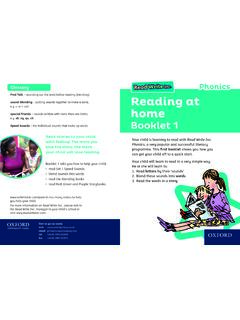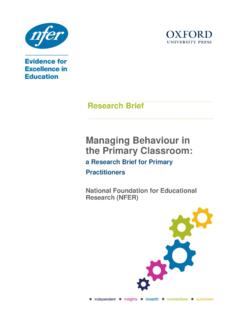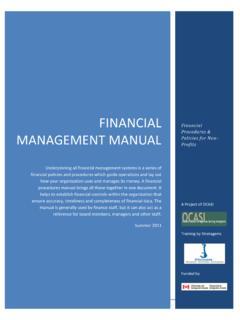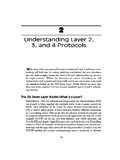Transcription of Teaching the Reading Curriculum - Oxford Owl
1 Teaching the Reading role of high-quality guided readingRevised and updated 2 017 Oxford School Improvement The purpose of this report is to signal how high-quality guided Reading has the potential to make a vital contribution to children s progress in takes a fresh look at guided Reading : what it is (and isn t), what it can be used for, how it might evolve at different stages, and how to organise it effectively and productively. The report is the latest in a series of reports intended to support teachers in building an outstanding Reading school. Who is this report for?This report is written mainly for subject leaders of English to support them in developing high-quality guided Reading and in providing continuing professional development (CPD). However, it will also be useful for initial teacher education, particularly for trainees and NQTs. One of the key findings in Ofsted s report From Training to Teaching was that nearly half the trainees [in the survey] were not sufficiently aware of how learning in one age group related to pupils previous and subsequent learning in language and literacy.
2 1 Why do guided Reading ?In its 2012 report Moving English Forward, Ofsted noted that: Many primary schools .. appear to believe that guided Reading in itself will improve standards. 2 As with any Teaching approach, it is not the process of guided Reading that raises standards: it is how the process is used that makes the difference. This is perhaps why some schools have abandoned guided Reading because they see it as a bolt on to their core reality is that well-planned, high-quality guided Reading , using carefully-chosen texts, and linked in with effective assessment, is a key part of the overall provision for Reading in a school. Synthetic phonics Teaching , whole-class English lessons, adults Reading to children, children s own independent Reading , and Reading across a range of subjects, all contribute to the progress children make as readers. Used well, and in conjunction with effective assessment, guided Reading has the potential to make a real difference to children s skills as readers, their understanding of what they read, their pleasure in Reading and their fluency.
3 It provides opportunities for introducing them to a wide range of texts and authors, with those choices matched closely to the needs and interests of particular groups. It provides good opportunities for children, among other things, to: Apply their phonic knowledge and skills Improve their fluency Discuss their understanding of what they read Gain new vocabulary Talk about grammar in context Discuss ideas and learn from one an outstanding Reading schoolCONTENTS 02 The purpose of this report04 The context for guided reading05 The Simple View of Reading06 Ofsted and the Teaching of reading08 Guided Reading in practice10 The benefits of guided reading12 Organising guided reading13 Guided Reading for extra support14 Guided Reading throughout a school 19 Resources to support the Teaching of Reading EndnotesThe purpose of this reportAs with any Teaching approach, it is not the process of guided Reading that raises standards.
4 It is how the process is used that makes the Teaching the Reading Curriculum Find out more at THE AUTHORS Janet BrennanJanet Brennan is an education consultant and spent 14 years as one of Her Majesty s Inspectors (HMI) in Ofsted, with particular involvement in literacy in primary schools and initial teacher education. During 2005/06 Janet was a member of the advisory panel for Sir Jim Rose s independent review of early Reading . She also worked with the Department for Education on the National Curriculum 2014 for primary English. Janet has been a teacher, a teacher trainer and a primary English adviser in a large local Clements For ten years, James was a teacher and senior leader at an outstanding inner-city primary school. He was also a local authority lead teacher, leading training, and supporting Teaching and learning across a network of schools. James was consulted on the 2014 National Curriculum for primary schools.
5 James is now an education writer and researcher, specialising in the Teaching of Reading , writing and drama. He is the founder of Shakespeare and More, a not-for-profit organisation that promotes effective English mythsThis report focuses on what is most important in Teaching guided Reading . Guided Reading was first introduced to schools in the early days of the carousel approach of the National Literacy Strategy s literacy hour in England. As time has gone on, and the old literacy hour has evolved and changed, myths and misunderstandings have grown up about it. However, provided it is planned and flexibly taught by highly-trained adults, guided Reading is a powerful and effective way of improving children s Reading . GOOD GUIDED and organisation organises groups around children s needs to ensure optimum conditions for learning is led by well-trained, knowledgeable staff reflects a strong, agreed rationale for allocating staff to different groups is organised so that any independent tasks are meaningful and serve to consolidate or extend children s learningPlanning, Teaching , learning draws on earlier assessments, matches the text closely to the pupils needs and has clear objectives is clear about whether the focus of the Teaching is primarily word Reading or comprehension requires children to apply phonic knowledge and skills as the prime approach to Reading an unknown word shows evidence of teachers and other adults good subject knowledge engages children actively has a positive impact on the progress children make in a lesson, including those with specific needs makes good provision, in planning.
6 For the groups that are working independentlyAssessment and groupings uses assessments well to group children initially and inform planning records the progress of each child not simply the group as a whole provides clear feedback to move children forward is flexible about moving children between guided Reading groups on the basis of assessmentsTexts provides phonically regular texts at the earliest stages so that children are required to apply their phonic knowledge and skills and their knowledge of common exception words matches texts effectively so that children develop their word Reading and comprehension in line with their needs introduces older children to a wide range of authors and genres, giving them the opportunity to encounter high-quality texts with language and ideas that will challenge guided Reading what it looks like Oxford School Improvement Find out more at Teaching the Reading Curriculum 03 Oxford School Improvement 04 Teaching the Reading Curriculum Find out more at aim of the National Curriculum is to raise expectationsabout what children should know, understand and be able to do by the end of Year 6.
7 It s about making sure that they enjoy language but also that they are very well-equipped to move to secondary of the critical elements of the National Curriculum have been familiar for a while, particularly the emphasis on systematic, synthetic phonics. The key distinction made in the programmes of study for Reading is between word Reading and language comprehension. These are the two dimensions of the Simple View of Reading that Sir Jim Rose drew on in his report on early Reading in 2006, which are further explained on page Understanding their implications is particularly important for Teaching Reading at the earliest children s word Reading is only just developing, most of their brain, quite literally, will be engaged in decoding the print on the page: there isn t enough cognitive capacity left over to process and understand information as well as decode. However, when children s word Reading is sufficiently fluent, they can process phonically regular words and tricky words common exception words, as the National Curriculum calls them quickly enough for their word Reading not to hold up their understanding.
8 The processes children need to understand written text are the same as those they need to understand what they hear. This is why the Simple View of Reading refers to language comprehension and not Reading comprehension . The main difference is that in Reading comprehension, because the text is written down not spoken, children gain access to it through their eyes and not their ears through the visual information of the print on the page. This is why it s vital that children s word Reading is as automatic and as fluent as it possibly can be. Children s comprehension improves whether they learn to read or not because they are taking in information from the world around them all the time. However, when they learn to read independently, they have a real chance to meet new vocabulary, including words that they might not come across in everyday life. This learning then feeds further into their comprehension. Guided Reading is an ideal context for all of this Teaching : for comprehension, for giving opportunities for children to apply their phonic knowledge and skills and to practise Reading fluently, and for developing their appreciation and love of Reading .
9 Ofsted s 2010 report, Reading by six, looked at the practice of 12 outstanding primary schools in terms of what they did in Reading . The report said that the diligent, concentrated and systematic Teaching of phonics was central to the success of those schools. It went on to emphasise: Pupils are given opportunities to apply what they have learnt through Reading , including time to read aloud toadults to practise their decodingskills writing and comprehensionof what they are Reading . 4 The context for guided readingAll pupils must be encouraged to read widely across both fiction and non-fiction to develop their knowledge of themselves and the world in which they live, to establish an appreciation and love of Reading , and to gain knowledge across the CurriculumThe National CurriculumIf a child is finding Reading difficult, ask yourself this question. If I read this to him, would he understand it? If the answer is yes, it s very likely that he is finding word Reading difficult and not comprehension.
10 It s a good starting point for further assessment, including finding out exactly what aspects of word Reading might be causing the TIPO xford School Improvement Find out more at Teaching the Reading Curriculum 05To get the mostfrom this report,it s worth revisitingthe Simple View of Reading model (Figure 1).The National Curriculum deals first with the horizontal axis word recognition: Skilled word Reading involves both the speedy working out of the pronunciation of unfamiliar printed words (decoding) and the speedy recognition of familiar printed words. Underpinning both is the understanding that the letters on the page represent the sounds in spoken words. This is why phonics should be emphasised in the early Teaching of Reading to beginners ( unskilled readers) when they start school. Second, it looks at the vertical axis: Good comprehension draws from linguistic knowledge (in particular of vocabulary and grammar) and on knowledge of the world.

















